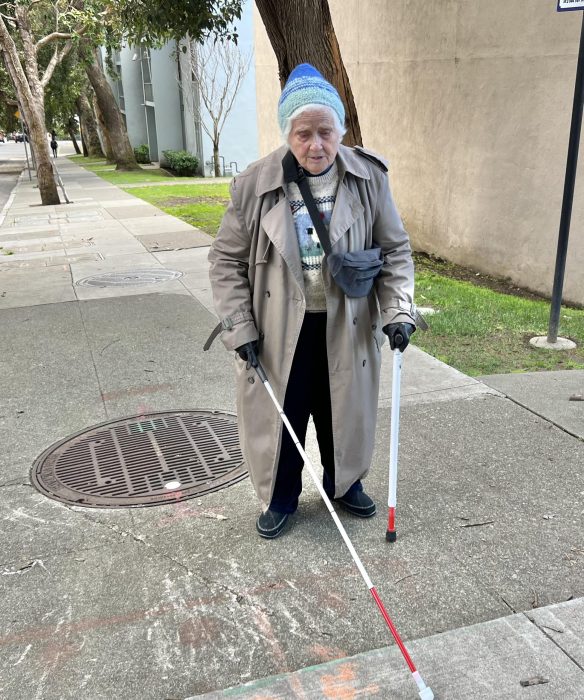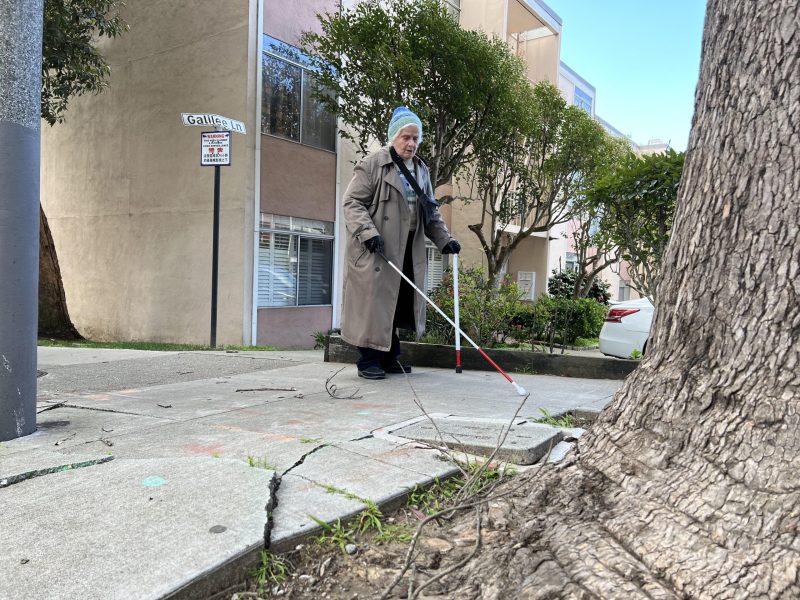Retired teacher who is legally blind memorizes the streets she travels to avoid “trippers”
It’s a walk of only about two-tenths of a mile from Meg Gorman’s apartment on Laguna Street to Geary Boulevard, which she crosses on her way to the Japan Center. But Gorman is legally blind and must contend with more than a dozen places where the sidewalk is broken or raised by tree roots.
She calls those spots “trippers,” and tripping, of course, is exactly what she strives to avoid. “I’m so afraid of falling,” she said. As a defense mechanism, the 79-year-old retired teacher has memorized the dangerous spots on the west side of Laguna Street and deftly avoids them with the aid of her white cane and walking stick. The east side of the street “is so bad, I never walk on it.”

Falls are dangerous for anyone, but for seniors, a tumble on concrete can be life-threatening.
Laguna is lined with eucalyptus trees, a fast-growing species that develops thick, gnarly roots capable of pushing up and cracking a sidewalk or curb. Most of the broken spots are marked with green paint, a sign that the city is aware of the problem. Yet, in the year or so Gorman has lived in the neighborhood, she’s noticed little, if any, repair work.
The city’s Public Works Department is responsible for repairs to sidewalks damaged by trees, but with 950 miles of streets and 12,900 blocks of sidewalks to monitor, keeping sidewalks in good repair is a Sisyphean task that costs the city some $20 million a year.
A 25-year inspection cycle
Public Works inspectors trawl the city’s sidewalks continuously, but on average, it takes 25 years to inspect every foot, said department spokeswoman Rachel Gordon. In a sense, it’s like painting the Golden Gate Bridge, a process that begins at one end, ends on the other, and then immediately starts again. By the time the crews come to the end of the quarter-century cycle, sidewalks they repaired earlier are yet again in need of maintenance.
The department gets reports of damaged sidewalks from its inspectors and from people who call its 311 line or use its app. By far, tree roots that break sidewalks and curbs elicit the most complaints. Problems are triaged using a “worst first” standard, Gordon said. The department prioritizes areas with high foot traffic and those that are close to vulnerable populations, areas where there are schools, hospitals, or senior centers.

“We respond to most requests within 48 hours,” she said. If someone has tripped and fallen, the city will cone off the area and sometimes make temporary repairs. Permanent fixes can take 60 days to 90 days.
‘Sidewalk Search Party’
That’s the theory. “But in reality, it doesn’t always happen. Residents keep telling me they are reporting the same issue over the years” said Jennifer Walsh, a staffer at the Community Living Campaign. She is the facilitator of the nonprofit’s “Sidewalk Search Party,” a monthly neighborhood walk in which volunteers look for – and report – tripping hazards.
“The sidewalk off the northeast corner of Joost Avenue and Ridgewood Street has been a broken pedestrian hazard for over two years,” a senior who responded to a survey by Walsh’s group said. “A rickety sawhorse is the only safety protection offered.”
In one particularly humiliating incident documented by Walsh, a man using a wheelchair became trapped in wet asphalt. The sticky patch had not been blocked with cones or barriers.
“There is a lot more going on than trees causing damage,” Walsh said. “There are no curb ramps, missing trees that leave gaping holes, and unsecured ramps around construction areas.”
And that’s the case on Laguna Street, where curbs are broken and there are numerous gaps where trees used to be, the kind of trippers Gorman needs to avoid.
Seniors voice concerns
Walsh, who uses a power wheelchair, spoke to her frustration over the condition of the city’s sidewalks that led her to form the search party: “Over the years, I have tipped over into the streets due to construction and empty tree wells. Many people with and without disabilities of all ages had similar experiences.”

In December 2021, the Land Use and Transportation Committee of the San Francisco Board of Supervisors held a hearing on sidewalk-related issues. Here’s some of what residents told the committee. (Names of the speakers have been withheld by CLC.)
- “I rounded the corner onto a side street and felt my foot hit concrete before I went flying forward. Then I looked at the sidewalk…large blocks of South of Market concrete.”
- A semi-truck driver was reversing inches from hitting a senior walking with a walker down the curb cut. A good Samaritan had to run over to tell the driver to stop moving.
- A blind pedestrian walked into unsecured and unmarked scaffolding and was hit by falling debris and taken to the hospital.
- “A part of the sidewalk had scaffolding, not lit! It was dark and I couldn’t go on the street because of cars in the lane next to the scaffolding. There was a piece of plywood; as I stepped on it, I could feel that it gave way, but it was too late. Down I went. It was a big fall, and I hit my upper lip.”
And in a survey of 165 San Franciscans, mostly seniors, Walsh’s group found that 93 percent of those asked said they frequently or sometimes encounter inaccessible or unsafe sidewalks and intersections. Asked if sidewalks in San Francisco are well maintained, 78 percent said they are not.
The city’s policy about sidewalks damaged by trees changed in 2017. Previously the property owner was responsible. Now the city will fix the damage caused by trees at no cost to the property owner. But sidewalks damaged in other ways are still the responsibility of the property owner.
How to report
Reporting hazardous sidewalks to the Public Works Department is easy. Here’s a direct link to make a report: https://sf311.org/services/sidewalk-defects. It’s helpful to upload a picture of the damaged area. Or you can download a mobile app: mobile SF311 app.
Gorman has never fallen on Laguna Street; after just a few round trips to the Japan Center, she had memorized the hazards. But when she travels elsewhere in the city, broken sidewalks scare her. When she’s in an unknown neighborhood, she’ll often ask a passerby to guide her. “People don’t say no,” she said. “They are happy to help.”





